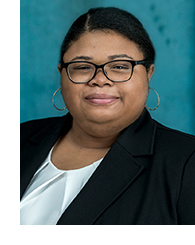A DAY IN THE LIFE OF A CHILDREN’S ADVOCACY CLINIC STUDENT
By Jamesha Caldwell ’25, a third-year law student at Penn State Dickinson Law
 Since starting law school, I have always known that my purpose was to be in service to others. Yet, as a first-year law student, I carried ambitious dreams that often collided with the constraints of Rule 5.5 of the Model Rules of Professional Conduct, which emphatically reminded me of my limitations. For a time, those boundaries felt like a quiet shadow, stunting my imagination about my capacity to be an advocate as a law student.
Since starting law school, I have always known that my purpose was to be in service to others. Yet, as a first-year law student, I carried ambitious dreams that often collided with the constraints of Rule 5.5 of the Model Rules of Professional Conduct, which emphatically reminded me of my limitations. For a time, those boundaries felt like a quiet shadow, stunting my imagination about my capacity to be an advocate as a law student.
During my second year, however, the clouds began to part when I discovered Dickinson Law’s clinic opportunities. These clinics offered a rare privilege for a handful of steadfast students to step beyond theoretical study and apply doctrinal lessons to real clients. The Children’s Advocacy Clinic (CAC), in particular, stood out to me because it promised not just professional growth but also the opportunity to make a meaningful impact through direct service to children and young adults navigating dependency proceedings.
Stepping into the world of dependency law as a clinic student revealed what it truly means to serve — not just in theory but in practice. As a clinic student, your identity shifts. You are no longer simply a law student functioning in the multifaceted roles of a paralegal or research assistant propping up a law practice.
Instead, you become a “baby lawyer,” entrusted with functioning as either a guardian ad litem — representing the best interests of the client — or an attorney — tasked with advocating for the client’s wishes. You are the advocate, the responsible authority on your client’s case. While this experience is both daunting and exhilarating, it is a transformative journey that forces you to cultivate the confidence and competence necessary to zealously represent clients whose lives and legal matters demand nothing less. So, what does a clinic student do over the course of a semester? In short: case administration, correspondence, client visits, multidisciplinary team meetings to address intersectional issues, research projects, motion drafting, conducting hearings, and countless other tasks that arise throughout the lifecycle of a client’s case.
Case administration forms the foundation of the clinic experience. Whether it’s your first day or your fortieth, you are assigned three to four clients, each accompanied by extensive files filled with reports, motions, orders, and histories. At first glance, the paperwork can feel overwhelming, but if approached as a fact-finding mission to piece together your client’s story, it becomes an opportunity to understand their hopes, challenges, and progress.
This procedural step not only ensures competency but also fosters a deeper connection with your client, demonstrating that you are not just in the clinic to learn but to advocate effectively and fully informed. Throughout the semester, you will continually engage with these files, adding notes and memorandums to keep your client’s team updated on developments, resources, and strategies. Diving into case administration quickly reveals two critical aspects: the multidisciplinary team members collaborating on your client’s case and the intersectional issues that need addressing. You will often find yourself scheduling and conducting meetings with team members such as social workers, caseworkers, teachers, special educators, juvenile probation officers, and mental health professionals. These meetings are vital for understanding the current issues and crafting interdisciplinary solutions tailored to your client’s needs.
Beyond team collaboration, meeting with your client is one of the most eye-opening and informative aspects of the semester. These visits provide a firsthand glimpse into the settings where your clients reside — whether under parental supervision, with kin, in foster care, in adoption placements, or at facilities. Such insights not only shape your advocacy but also help establish a meaningful rapport with your client, allowing them to become a beacon of information and guidance in their own case.
The information gathered from client visits and team meetings is brought back to case reviews with your clinic supervisor, the clinic social work supervisor, and the clinic social work intern. That’s right — the CAC has an in-house social work program where law students work in a dynamic learning environment alongside local university social work students to address client matters from a dual perspective. During case reviews, clinic students and social work interns use the space to discuss case updates, issue spot, and brainstorm solutions based on the needs of the case. Case reviews ensure that every angle is considered, offering a collaborative forum to develop strategies for achieving the best outcome for your client.
As the semester progresses, all the work culminates in dependency hearings, with clinic students typically handling three to four hearings per term. This is where preparation meets performance. After weeks of immersing yourself in your client’s case, researching files, meeting with your client, collaborating with team members, and strategizing with colleagues, you step into the hearing ready to advocate zealously. These moments reinforce the skills you’ve developed and also remind you of the profound impact legal advocacy can have on real lives.